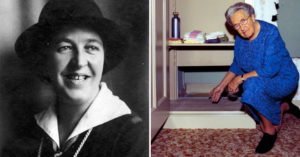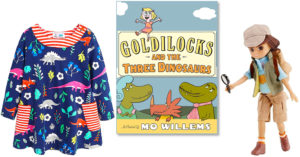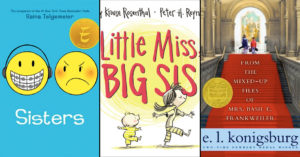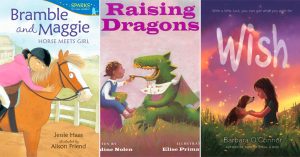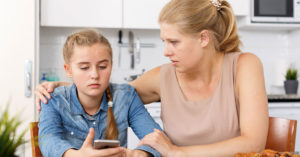By Katherine Handcock, A Mighty Girl Communications Specialist
February is National Eating Disorder Awareness Month, which makes it the perfect time to begin a conversation with your Mighty Girl about body image, self-esteem, and unhealthy eating patterns. The most well-known of these disorders are anorexia (the severe restriction of calorie intake) and bulimia (binge eating and purging), but there are many other ways in which people can develop an unhealthy relationship with food and a distorted image of their body — and, at least at present, girls, especially teenaged girls, are the most prone to these disorders.
If you've been looking to have this conversation with your tween or teen, this post will provide a variety of resources you can use to discuss eating disorders with your Mighty Girl and the real effects these unhealthy behaviors can have on the body.
Please note that the fictional books and autobiographies featured below are not intended to be self-help books for youth with disordered eating problems. Such works are intended to provide fodder for discussion and exploration of this issue. They are best read under the guidance of a parent or teacher and are not recommended for those currently experiencing or predisposed to an eating disorder. You can read more about the merits and potential problems with books about eating disorders in a NY Times article on The Troubling Allure of Eating-Disorder Books.
Dying to Be Thin: The Basics About Eating Disorders
![518yjwwd7zl_1_[1]](https://www.amightygirl.com/wp/wp-content/uploads/2013/02/518yjwwd7zl_1_1-211x300.jpg) Although many people think of eating disorders as rare, nearly half of all Americans will know someone who struggles with disordered eating — whether they realize it or not. Since nearly 95% of those diagnosed with an eating disorder are between the ages of 12 and 25, chances are good that your Mighty Girl will personally see the risks and consequences of these unhealthy behaviors at some point during her life.
Although many people think of eating disorders as rare, nearly half of all Americans will know someone who struggles with disordered eating — whether they realize it or not. Since nearly 95% of those diagnosed with an eating disorder are between the ages of 12 and 25, chances are good that your Mighty Girl will personally see the risks and consequences of these unhealthy behaviors at some point during her life.
The first step to helping girls recognize and prevent the emergence of eating disorders in themselves and in their friends is education. Girls need to know how truly disordered eating differs from a healthy diet and how an active exercise regimen differs from extreme exercise or exercising to purge calories. It's also important for girls to understand how a person's perception of their body changes while in the thrall of an eating disorder: that they can be convinced that they are too fat, even as they are admitted to a hospital for being dangerously thin.
Nova’s 2004 documentary Dying to Be Thin gives a general introduction to anorexia and bulimia for all ages and addresses how images of women in the media — whose body weight often approaches 25% below the average — create pressure to lose weight which can lead to unhealthy thinking. This documentary is a great starting point for any discussion of eating disorders, since it addresses causes, symptoms, consequences, treatment, and recovery.
Inside An Eating Disorder: Books for Tweens and Teens
The tween years are when most girls will start being more critical of their bodies, especially since the natural processes of puberty can make their bodies feel very foreign. Fostering positive self esteem is crucial, but so is helping girls identify when occasional negative thoughts start turning into disordered thinking. Deborah Hautzig’s novel Second Star to the Right (age 10 - 15), was first published in 1981 and has become a classic story about the struggle with anorexia. Leslie, the main character, is so fearful that she will fail someone — parents, friends, teachers — that she comforts herself with total control in one area: how much food she eats. Hautzig’s afterword, in which she recounts her own battle with anorexia, provides a bridge between fiction and reality.
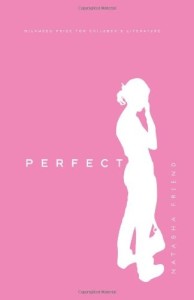 Another novel that explores the emotional aspects of eating disorders is Perfect: A Novel by Natasha Friend (age 11 - 15). In Friend’s novel, Isabelle deals with her grief over her father’s death and her mother’s subsequent depression by binging and purging. When she’s sent to a support group, she learns that Ashley, the most popular girl she knows, shares her disorder. Soon, Ashley has shepherded Isabelle into the most exclusive clique in school but she’s also teaching Isabelle more and “better” ways to binge and purge. Isabelle has to decide what she wants: superficial perfection and popularity in an unhealthy life, or imperfection and painful healing and recovery. This book also introduces a difficult aspect of treating eating disorders: the risk that bringing sufferers together can normalize their disordered thinking.
Another novel that explores the emotional aspects of eating disorders is Perfect: A Novel by Natasha Friend (age 11 - 15). In Friend’s novel, Isabelle deals with her grief over her father’s death and her mother’s subsequent depression by binging and purging. When she’s sent to a support group, she learns that Ashley, the most popular girl she knows, shares her disorder. Soon, Ashley has shepherded Isabelle into the most exclusive clique in school but she’s also teaching Isabelle more and “better” ways to binge and purge. Isabelle has to decide what she wants: superficial perfection and popularity in an unhealthy life, or imperfection and painful healing and recovery. This book also introduces a difficult aspect of treating eating disorders: the risk that bringing sufferers together can normalize their disordered thinking.
Teens are ready for more detailed consequences of eating disorders, both physical and emotional. In the novel Wintergirls by Laurie Halse Anderson (age 13 and up), Lia and Cassie are best friends — but they're also competitors in weight loss. When Cassie dies, Lia is left behind to deal with her guilt and to decide if she will follow Cassie or attempt to recover. This book will emphasize for teens that anorexia is a deceptively dangerous illness, one which can, in fact, be fatal — but also that it is one that can be overcome.
For people watching a friend or loved one with an eating disorder, the experience can be terrifying, especially if it appears that recover will not happen in time. In Never Enough (age 13 and up), Loann has always been jealous of her popular and pretty sister, Claire, until she realizes that Claire's determination for perfection has slipped into an eating disorder that is threatening the whole family — and Claire's life. As Claire withdraws into her disorder, ignoring family and friends, Loann struggles to understand, make amends, and heal their relationship in hopes that doing so will also heal her sister's disorder.
![41irvnki5rl_1_[1]](https://www.amightygirl.com/wp/wp-content/uploads/2013/02/41irvnki5rl_1_1-192x300.jpg) Another gripping look at the slide into an eating disorder appears in Letting Ana Go, an anonymous fictional journal with an unnamed main character (age 13 and up). As the author's parents separate and she feels increasingly out of control, she finds a way to feel balanced again by denying herself food — and for a while, she feels strong, capable of handling anything. Although her sports coaches and others have warned about the dangers of anorexia ("ana", as it's commonly abbreviated by those in the grip of the disorder), the slide from discipline into disorder is a subtle one, and one the main character misses when it happens. This novel also refers to the online "thinspiration" community — websites and forums where people with eating disorders share tricks for losing weight — and captures the ultimate danger of an inability to "let ana go" and seek recovery.
Another gripping look at the slide into an eating disorder appears in Letting Ana Go, an anonymous fictional journal with an unnamed main character (age 13 and up). As the author's parents separate and she feels increasingly out of control, she finds a way to feel balanced again by denying herself food — and for a while, she feels strong, capable of handling anything. Although her sports coaches and others have warned about the dangers of anorexia ("ana", as it's commonly abbreviated by those in the grip of the disorder), the slide from discipline into disorder is a subtle one, and one the main character misses when it happens. This novel also refers to the online "thinspiration" community — websites and forums where people with eating disorders share tricks for losing weight — and captures the ultimate danger of an inability to "let ana go" and seek recovery.
Rather than a fictional account, teens may want to read a memoir of the journey into — and away from — eating disorders. In Marya Hornbacher’s Wasted: A Memoir of Anorexia and Bulimia, teens can read a first-hand account of a life with these diseases: hospitalization, institutionalization, and at one point, a prediction of one week to live. Hornbacher removes the “glamor” of eating disorders, describing in full detail the constant terror of eating, food, and weight gain. She also reminds the reader that beauty and starvation are not compatible, including vivid descriptions of protruding bones and lanugo, the furry hair growth that develops when the body has no fat. This painful but compelling read is best suited to older teens 16 and up.
How You Can Help: Parenting Books About Eating Disorders
![41anlt3wapl_1_[1]](https://www.amightygirl.com/wp/wp-content/uploads/2013/02/41anlt3wapl_1_1-199x300.jpg) Parents can do a lot to help their daughters avoid the trap of an eating disorder! These books for parents talk frankly about the early signs and symptoms of eating disorders — and how parents can contribute to an environment where girls develop a health relationship with food, exercise, and their bodies.
Parents can do a lot to help their daughters avoid the trap of an eating disorder! These books for parents talk frankly about the early signs and symptoms of eating disorders — and how parents can contribute to an environment where girls develop a health relationship with food, exercise, and their bodies.
For an introduction to the many ways eating disorders can present, check out Thin by Lauren Greenfield. In addition to personal stories from a variety of girls and women about their own struggles with disordered eating, Greenfield presents thoughtful discussions from psychologists, sociologists, and other researchers about what we know about the cultural and physical aspects of eating disorders. With compelling and often shocking stories and pictures, this book provides an introduction for adults to the world of severe eating disorders.
Many parents wonder why so many girls are struggling with eating and weight. In Perfect Girls, Starving Daughters: The Frightening New Normalcy of Hating Your Body, Courtney E. Martin tackles how society's messages that girls must be perfect — whether in their behavior or in their appearance — create an environment where extreme control over your body is normal, even reassuring. Martin argues that many girls, instead of hearing they can "be anything", hear that they must "be everything", including thin. This fascinating discussion of the relationship between cultural expectation and eating disorders is sure to be illuminating.
![51jku59b9cl_1_[1]](https://www.amightygirl.com/wp/wp-content/uploads/2013/02/51jku59b9cl_1_1-192x300.jpg) How do you know if your daughter's behavior is crossing the line into a disorder? In Almost Anorexic: Is My (Or My Loved One's) Relationship With Food A Problem?, Jennifer J. Thomas and Jenni Schaefer discuss which symptoms are the warning signs of a developing disorder, and how you can intervene effectively. The book provides scientifically proven strategies for changing unhealthy diet or exercise patterns, as well as a guide to determining when professional help is necessary. For parents concerned about their own children, this book will be a useful resource.
How do you know if your daughter's behavior is crossing the line into a disorder? In Almost Anorexic: Is My (Or My Loved One's) Relationship With Food A Problem?, Jennifer J. Thomas and Jenni Schaefer discuss which symptoms are the warning signs of a developing disorder, and how you can intervene effectively. The book provides scientifically proven strategies for changing unhealthy diet or exercise patterns, as well as a guide to determining when professional help is necessary. For parents concerned about their own children, this book will be a useful resource.
Of course, some people manage to dance the line between healthy behaviors and clinical diagnosis. Chronic dieters or overexercisers may have an unhealthy relationship with their bodies without being considered actively anorexic or bulimic. In Life Inside the "Thin" Cage: A Personal Look Into The Hidden World of the Chronic Dieter, Constance Rhodes talks about the experience of living life on that borderline. She describes how "sub-clinical" behaviors can still cause significant physical and emotional problems, and provides tips and personal stories that address how to seek a healthier balance without a diagnosis. Rhodes provides guidance in recognizing what drives a chronic dieter and how to know when you, or someone you love, is starting to cross the line.
Working Towards Recovery: Resources for Girls and Parents
![517zkxyth3l_1_[1]](https://www.amightygirl.com/wp/wp-content/uploads/2013/02/517zkxyth3l_1_1-240x300.jpg) The good news is that, with help, people struggling with eating disorders can seek recovery. While treatment can be hard to find — only 1 in 10 people with eating disorders currently receive treatment, and many of those do not get the intensity or duration of treatment recommended. However, even with current treatment statistics, 30 to 40% of sufferers will achieve full recovery. Early treatment improves those odds, since people who have reinforced their disordered perceptions over many years will find it harder to establish new ones. The books in this section will help tweens, teens, and their parents find ways to help early on if they're concerned about someone in their lives.
The good news is that, with help, people struggling with eating disorders can seek recovery. While treatment can be hard to find — only 1 in 10 people with eating disorders currently receive treatment, and many of those do not get the intensity or duration of treatment recommended. However, even with current treatment statistics, 30 to 40% of sufferers will achieve full recovery. Early treatment improves those odds, since people who have reinforced their disordered perceptions over many years will find it harder to establish new ones. The books in this section will help tweens, teens, and their parents find ways to help early on if they're concerned about someone in their lives.
Tweens and teens who think they know someone with an eating disorder may feel like they are caught between needing to help and protecting the friendship. The book I’ve Got This Friend Who...: Advice for Teens and their Friends on Alcohol, Drugs, Eating Disorders, Risky Behavior, and More from KidsPeace, a nonprofit organization that serves children and families in crisis, may provide guidelines for how to help. While eating disorders are only a part of this book, it provides great tips for how to recognize signs that someone is in need of help, how to find assistance, and how to ensure that you don’t become overwhelmed by the problems of others.
For teens who are recovering from eating disorders, What's Eating You?: A Workbook for Teens with Anorexia, Bulimia, and Other Eating Disorders by Tammy Nelson (age 13 and up), from the Instant Help Solutions series, provides a step-by-step workbook to help identify behaviors, spot the relationship between emotions and disordered eating, and develop positive body image and the confidence needed to establish healthy patterns of diet and exercise for the future.
![51exfhsjvil_1_[1]](https://www.amightygirl.com/wp/wp-content/uploads/2013/02/51exfhsjvil_1_1-199x300.jpg) If you are a parent and you are concerned about your child, Help Your Teenager Beat an Eating Disorder by James Lock, MD PhD, and Daniel Le Grange, PhD — two experts on the treatment of eating disorders — gives advice for parents on how to identify whether your child is showing signs of a disorder and how to support them in their recovery, something that requires both addressing the disorder and building new, healthy attitudes towards food and the body. This book, which was just released in a second edition incorporating the most recent research, will help a family find recovery together.
If you are a parent and you are concerned about your child, Help Your Teenager Beat an Eating Disorder by James Lock, MD PhD, and Daniel Le Grange, PhD — two experts on the treatment of eating disorders — gives advice for parents on how to identify whether your child is showing signs of a disorder and how to support them in their recovery, something that requires both addressing the disorder and building new, healthy attitudes towards food and the body. This book, which was just released in a second edition incorporating the most recent research, will help a family find recovery together.
We leave you with words from Courage by Superchick, a beautiful song that explores recovery from eating disorders:
You should know you're not on your own
These secrets are walls that keep us alone
I don't know when but I know now
Together we'll make it through somehow
For information on where to learn more about eating disorders or how to get help, please check out these sites:
- The National Eating Disorder Association (NEDA) in the US offers a variety of resources on their website. Their helpline (1-800-931-2237) is available Monday to Friday, 9 am to 5 pm EST.
- In Canada, the National Eating Disorder Information Centre (NEDIC) provides information, including a service provider directory and a resource library. Their helpline (1-866-633-4220) is available Monday to Friday, 9 am to 9 pm EST.
- In the UK check out Beat, which offers adult and youth helplines (the youth line includes a call back service to save the cost of the call): http://www.b-eat.co.uk/
- In Australia, the Butterfly Foundation offers an eating disorders helpline at 1.800.ED.HOPE.
- For an international list of treatment centers for eating disorders, check out Eating Disorder Hope’s list.
Recommended Reading Resources
- For more books focused on body image issues, visit A Mighty Girl's Body Image section.
- For parenting books about helping girls build positive relationships with their bodies, visit our Body Image / Self-Esteem section.
- For parenting books to inspire a healthy, active lifestyle, visit our Healthy Living section.
Help keep A Mighty Girl growing in the years ahead!
If you discover any books or other resources via this post that you would like to purchase, please use the "Buy at Amazon" link on every A Mighty Girl product page. By doing so, at no added cost to you, you help to support the site and allow us to continue providing you with wonderful girl-empowering resources. Thanks for your support!









![51ol6x74cfl_1_[1]](https://www.amightygirl.com/wp/wp-content/uploads/2013/02/51ol6x74cfl_1_1-189x300.jpg)
